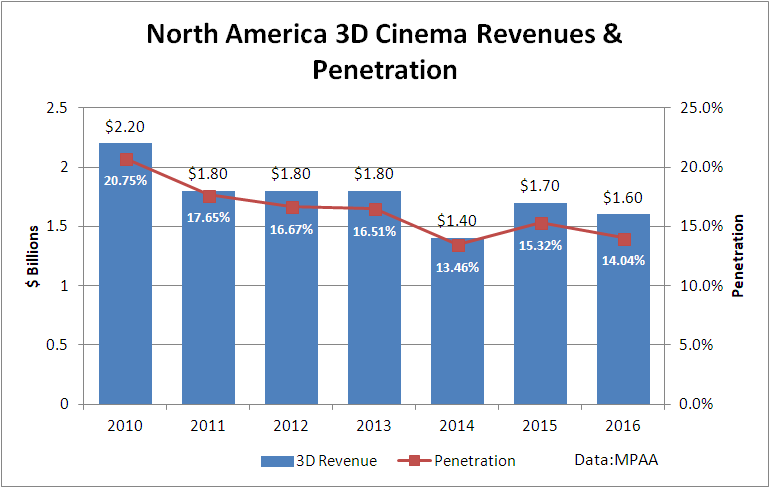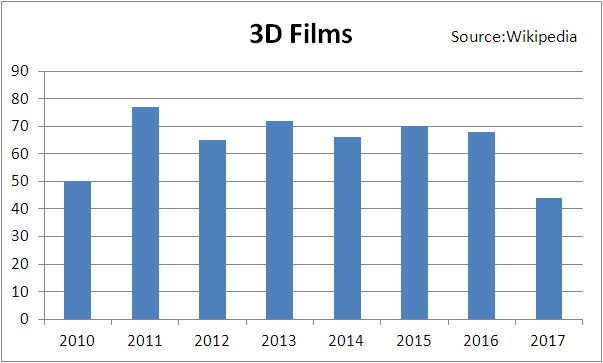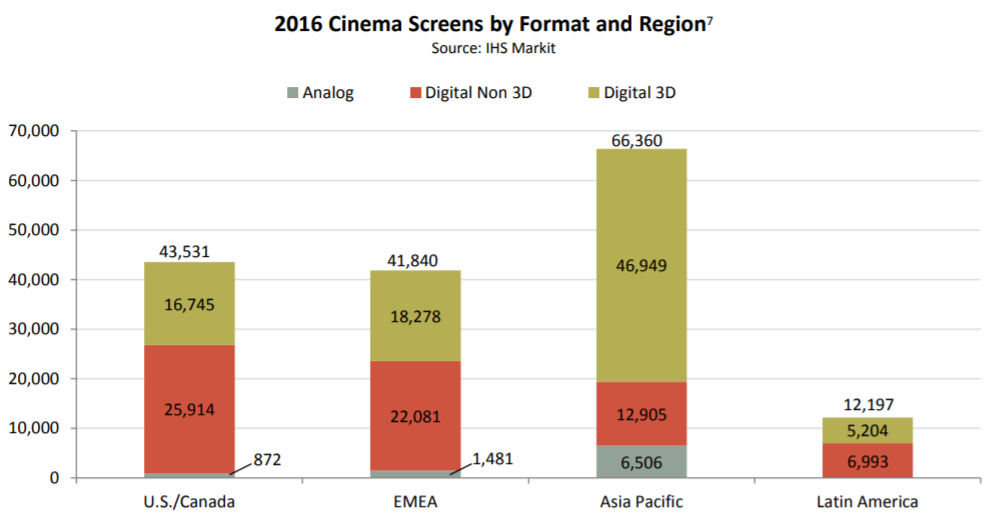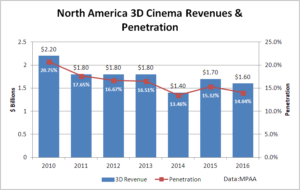After the false dawn of 3D on TV, cinema was the remaining key market for 3D display and content, but now Imax Entertainment CEO, Greg Foster, has said that the technology would no longer be the company’s default for new titles. This summer’s hit movie, Dunkirk, is not being shown in 3D.

3D TV was something of a marketing disaster, with a lack of standards, incompatibility between different makers’ systems, poor quality in many cases in content and display and difficulties in capturing and creating content. However, the cinema business did a much better job of managing these factors and created compelling experiences. Personally, I thought Avatar and Gravity in 3D were really great, while an analyst friend who was sceptical of the value of 3D told me that he found Avatar really ‘flat’ when he saw it on a TV in 2D having seen it in 3D at the cinema.
However, the Motion Picture Association of America collects data on the cinema market and has reported that the revenues for 3D cinema have declined from a peak of 20.75% of the overall North American box office revenues in 2010 (with 3D content including Toy Story 3, Alice in Wonderland and from Avatar which was released at the end of 2009).
 In North America, 3D cinema has been declining in share from a peak in 2010. Chart:Meko. Data:MPAA
In North America, 3D cinema has been declining in share from a peak in 2010. Chart:Meko. Data:MPAA
Cinema content in 3D seems to be slowing down and that won’t be helping. As I wrote about a couple of weeks ago, the summer blockbuster, Dunkirk, was filmed in iMax, but not produced in 3D although many of the shots that I have seen of it (I haven’t been to the cinema to watch) would seem to have been good prospects for 3D effects. However, “The Jungle Book” earned 43% of its opening weekend revenues in 3D. One reason may be that this version was conceived from the beginning as a 3D presentation and used both 3D and Dolby Atmos sound to try to ensure that the 3D was compelling.
 3D Hollywood films are declining, slowly. Source:Wikipedia
3D Hollywood films are declining, slowly. Source:Wikipedia
Of course, although the US is the largest market, it is far from the only cinema market and the MPAA, quoting data from IHS Markit, published this data showing the installed base of different cinema projection technologies and this highlights the stronger installed base of 3D projectors outside the US.
 The MPAA Reports on 3D cinema screens which are more available outside North America. Source:IHS Markit
The MPAA Reports on 3D cinema screens which are more available outside North America. Source:IHS Markit
Imax creates around 35 films per year and the CEO of Imax Entertainment, Greg Foster, has said that he estimates that five to ten titles would be released in 3D annually in the future. It seems to me that if there were fewer 3D titles, but with better 3D content, planned, like Avatar and The Jungle Book, to look really good in 3D, then the format would be much more popular. Bad 3D is worse than no 3D.
As Chris wrote recently (The LED Cinema Era has Started), we are entering a new era for cinema with the arrival of LED cinema. Although Samsung has only so far shown 2D, as far as I am aware, but at the Display Summit in 2016, Chao Li of Central China Display Laboratories talked about his technology for showing 3D on LED displays. (DS20 Li Solves the Problem with 3D – subscription required)
Li believes that quite a lot of the human factors problems in watching 3D come from timing differences between the left and right eye images in most 3D implementations. At Infocomm last year, his firm showed a 3D LED display and I was very impressed with the 3D effect. Of course, it was just a demo, but a 3D polarising LED cinema system could be very compelling as polarising technology means light and cheap glasses (and even allows regular glasses to be optimised for cinema viewing), no flicker and doesn’t even reduce the vertical resolution as those supporting time-based 3D suggest. Ray Soneira showed that in his work on LG’s polarisation-based TVs.
The other big advantage of LED is that there is nothing like the low level of brightness that is seen in commercial 3D presentations. I have seen the fantastic 3D presentations by Christie at IBC of really bright projected 3D, and it’s compelling, but the reality is that the cost of this technology may be too much for commercial installations. 6P laser also needs expensive glasses. – Bob Raikes

